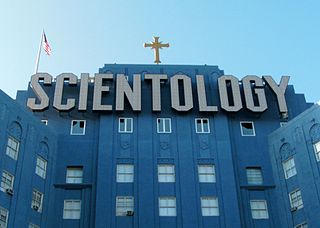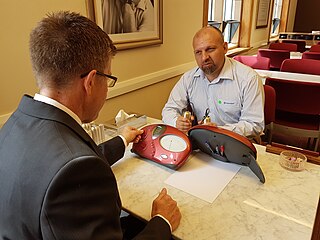Narconon International is a Scientology organization which promotes the theories of founder L. Ron Hubbard regarding substance abuse treatment and addiction. Its parent company is the Association for Better Living and Education (ABLE), which is owned and controlled by the Church of Scientology. Headquartered in Hollywood, California, United States, Narconon operates several dozen residential centers worldwide, chiefly in the U.S. and western Europe. The organization was formed in 1966 by Scientologist William Benitez with Hubbard's help, and was incorporated in 1970.

Followers of the Scientology movement maintain a wide variety of beliefs and practices. The core belief holds that a human is an immortal, spiritual being (thetan) that is resident in a physical body. The thetan has had innumerable past lives, some of which, preceding the thetan's arrival on Earth, were lived in extraterrestrial cultures. Based on case studies at advanced levels, it is predicted that any Scientologist undergoing auditing will eventually come across and recount a common series of past-life events.
Detoxification or detoxication is the physiological or medicinal removal of toxic substances from a living organism, including the human body, which is mainly carried out by the liver. Additionally, it can refer to the period of drug withdrawal during which an organism returns to homeostasis after long-term use of an addictive substance. In medicine, detoxification can be achieved by decontamination of poison ingestion and the use of antidotes as well as techniques such as dialysis and chelation therapy.

A Volunteer Minister (VM) is a member of Scientology sent to a disaster zone to spread the doctrine of Scientology and provide disaster relief. The program was created in the 1970s by Scientology founder L. Ron Hubbard.

Auditing, also known as processing, is the core practice of Scientology. Scientologists believe that the role of auditing is to improve a person's abilities and to reduce or eliminate their neuroses. The Scientologist is asked questions about past events while holding two metal cylinders attached to an electrical resistance meter (galvanometer) with a dial. The term "auditing" was coined by L. Ron Hubbard in his 1950 book Dianetics: The Modern Science of Mental Health, which describes the process.

Criminon is a program for rehabilitating prisoners using L. Ron Hubbard's teachings. Criminon International, a non-profit, public-benefit corporation managing the Criminon program, was spawned from Narconon International in 2000, and is part of Association for Better Living and Education's public outreach programs. Criminon is promoted by the Church of Scientology International. Independent experts contend that methods used by the program are not supported by any scientific studies.

Tory Christman is an American critic of Scientology and former member of the organization. Originally brought up a Catholic, Christman turned to Scientology after being introduced to the book Dianetics: The Modern Science of Mental Health authored by Scientology founder L. Ron Hubbard while staying with her parents in Chicago. She identified with concepts described in the book including the idea of attaining the Scientology state of clear, and became a member of the organization in 1969. She hitchhiked from Chicago to Los Angeles, in order to begin the process of studying Scientology, and initially felt that it helped improve her life. In 1972, she joined the core group of staff members within Scientology called the Sea Org. After being a member of the Scientology organization for ten years, Christman reached the spiritual Operating Thetan level of OT III, and learned the story of Xenu. She subsequently rose to a higher Operating Thetan level of OT VII, the second-highest within the organization. Her medical condition of epilepsy caused difficulty while in Scientology, as the organization did not approve of taking medication in order to manage her condition.
Dianazene was the name given by L. Ron Hubbard to a vitamin compound containing iron, vitamin C, and various B vitamins, including especially large doses of niacin.

This is a Timeline of Scientology and its forerunner Dianetics, particularly its foundation and development by author L. Ron Hubbard as well as general publications, articles, books and other milestones.

This bibliography of Scientology includes Scientology and Dianetics-related books, periodicals and other issues authored by L. Ron Hubbard and those produced by the Church of Scientology and its related organizations. Books bearing L. Ron Hubbard's name are considered texts of Scientology's canon.
The amount of material on Dianetics and Scientology is extensive, to say the least. This material is composed of books by L. Ron Hubbard ; compilations of his works; taped lectures; auditor training materials ; course packages; booklets; a large number of magazines and annuals; and video recordings of the major annual events.

Clear Body, Clear Mind is a Scientology book compiled from L. Ron Hubbard material from the 1960s, which was published posthumously in 1990 by Bridge Publications, the Church of Scientology's publishing house. The book is considered part of Scientology's canon. It is the textbook for the Purification Rundown ("Purif"), which Scientologists believe is a detoxification program with medical and spiritual benefits, but has been criticized as pseudoscientific by medical professionals who have called it "dangerous", "quackery," and "in some cases lethal".

All About Radiation is a Scientology book by L. Ron Hubbard on the subject of radiation and atomic bombs, and the effects on the human body, including techniques for reducing or eradicating those effects. It was first published in 1957 by the Hubbard Association of Scientologists International (HASI) and printed by Speedwell Printing Company, Kent, England. Later editions were published by the Church of Scientology's in-house publishing companies. The book is considered part of Scientology's canon, however is no longer in print or being sold by the Church of Scientology.

The Citizens Commission on Human Rights International (CCHR) is an anti-psychiatry lobbying organization established in 1969 by the Church of Scientology and psychiatrist Thomas Szasz. Headquartered in Los Angeles, California, its stated mission is to "eradicate abuses committed under the guise of mental health and enact patient and consumer protections." It is regarded by most non-Scientologists as a Scientology front group whose purpose is to push the organization's anti-psychiatry agenda.

Scientology in the United Kingdom is practised mainly within the Church of Scientology and its related groups which go under names including "Hubbard Academy of Personal Independence" and "Dianetics and Scientology Life Improvement Centre". The national headquarters, and former global headquarters, is Saint Hill Manor at East Grinstead, which for seven years was the home of L. Ron Hubbard, the pulp fiction author who created Scientology. In the 2021 census, there were 1,844 individuals in England and Wales who listed themselves as Scientologists in their census returns, almost half of which lived in the area around East Grinstead in West Sussex, which hosts the British Scientology Headquarters at Saint Hill Manor. This is a decline of just under a quarter since census day, 2011.
The Second Chance Program is a controversial detoxification and rehabilitation program based on the ideas of L. Ron Hubbard, the founder of the Church of Scientology. It focuses on individuals convicted of substance abuse offenses. The program utilizes a combination of saunas, vitamins, minerals and oils to tackle the effects of drug addiction. Other elements of the program aim to improve the educational and social abilities of inmates, and to instil a moral code for them to live by. First established in Baja California, Mexico, in 1995, Second Chance has attracted controversy over its methods and claimed success rates.

The New York Rescue Workers Detoxification Project was founded in New York City in 2003 with the stated purpose of treating rescue workers for toxins inhaled from the smoke of the September 11 attacks. It has two clinics: Downtown Medical on Fulton Street, two blocks from the site of the World Trade Center, and another at Williston Park, Long Island. The project's co-founder and top fundraiser is actor Tom Cruise. It uses the Purification Rundown, a detoxification program invented by L. Ron Hubbard as part of Scientology's Bridge to Total Freedom. This rundown has been criticized by many doctors as pseudoscientific and medically dangerous. It was reported in October 2007 that 838 people had completed the New York program.
Scientology in Egypt has no official presence because non-monotheistic religions are not recognized in Egypt. The Church of Scientology has claimed that Egypt is one of the "countries in which Dianetics and Scientology services are ministered", but there are no known membership statistics available. In 2002, two Scientologists were detained by Egyptian authorities under the charges of "contempt of religion". As of 2010, books authored by Scientology founder L. Ron Hubbard and printed by the Church of Scientology for its front groups were being distributed in Egypt—even bearing the approval of Al-Azhar, the highest Sunni learning institution in the Muslim world. Narconon, an organization that promotes Hubbard's drug abuse treatment, has a branch in Ismailia Governorate called "Narconon Egypt".

David Emerson Root is a United States Air Force physician known for promoting Niacin Protocol Sauna Detoxification to treat chemical exposure.

Scientology front groups are those groups named or operated in such a way as to disguise their association with the Church of Scientology (COS). COS uses front groups to promote its interests in politics, to make itself appear legitimate, and to recruit. The Times published, "[The church attracts] the unwary through a wide array of front groups in such businesses as publishing, consulting, health care and even remedial education." Many of the groups are founded on pseudoscience, named disingenuously, and underplay their links to Scientology.










